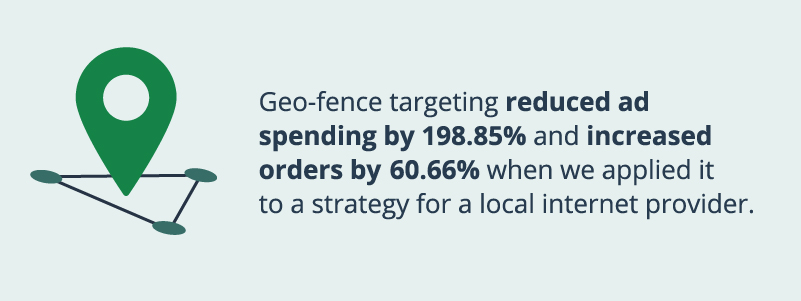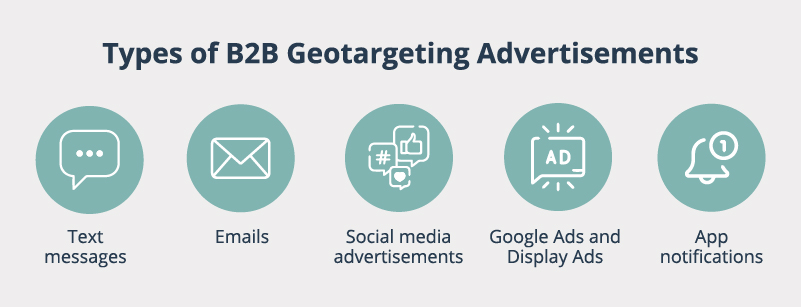We’re always interested in techniques that allow us to get more granular with our targeting, particularly if we can offer deeper customer personalization. As a result, we’ve opted to include more geofencing within our B2B content strategies.
Even if you’re remotely familiar with our topic, you may be curious about why or how we use geofencing in B2B marketing because it’s generally associated with B2C advertising. Alternatively, this could be the first you’re hearing about it, so let’s start with a primer before diving into how it’s leveraged.
What is Geofencing?
Think of geofencing as a digital border designed to capture folks’ attention through targeted advertising sent after someone enters a specific boundary. Those responses trigger based on customer location data from Radio Frequency Identification (RFID), GPS info, Bluetooth beacons, or an internet connection from a mobile device or computer once someone enters a digitally fenced area.
In simpler terms, a B2B marketer sets up a virtual fence, a prospect enters that zone, and a notification or advertisement triggers.
Types of B2B Geotargeting Advertisements
- Text messages
- Emails
- Social media advertisements
- Google Ads and Display Ads
- App notifications
The Benefits of B2B Geofencing
The Business Journals labeled geofencing a marketing goldmine because it offers new ways to reach consumers through targeted ads—we’re inclined to agree. Still, there are plenty of other benefits this kind of marketing offers B2Bs, including:
- Gaining better customer insights
- Improved geographic targeting
- Learning more about competitors
- Increased advertising engagement
- Enhances brand awareness
- Elevates sales enablement through deeper personalization
Common Ways B2Bs Use Geofencing
In B2B marketing, the virtual border might be an industry expo or a professional district where potential leads may work. B2B customers might also use it to grant exclusive access to an industry app within specific boundaries.
Using a tradeshow as an example, B2B marketers could leverage geofencing that targets a specific industry expo to promote a service or tool. Alternatively, geofencing could target a particular persona within a broader boundary—like a zip code—to better understand them through data.
Geofencing in B2B marketing also offers a competitive advantage by allowing folks to learn about their competitors and customers in specific locations, making it an useful tool for understanding professional landscapes.
Which B2B Brands Should Use Geofencing?
Most B2B outfits should consider adding geofencing if the goal is to target specific groups or customers within particular areas. However, to get more granular, we’ll highlight five verticals that have an advantage over others when using this type of marketing.
Software as a Service (SaaS): Use geotargeting to target leads and your competition in tech hot spots or industry events. Triggered responses could involve a link to a downloadable or an invite to demo a service.
Sales Enablement: Use geofencing to serve personalized content to qualified leads while targeting folks in the right areas and circumstances. Sales can also exclude poorly performing areas to improve lead scores and dial-in targeting.
B2B Marketing: Gain valuable customer insights and trigger events based on specific B2B needs. Leverage Display Ads, social networks, landing pages, and other digital channels to connect with leads within a specific location while lowering ad spending.
Fulfillment and Logistics: Provide localized shipping offers or introduce yourself to businesses looking to expand their reach locally. Initiate an invite to set up a consultation if customer information is available or serve digital advertisements to attract attention.
Local B2B Brands: Use geotargeting locally to target businesses that could benefit from your services or goods. Triggered events could be a Display Ad or social advertisement that increases brand awareness if quality customer data isn’t available.
Interested in Learning More About B2B Geofencing?
Geofencing provides a wealth of opportunities for brands looking for new tactics to reach energized leads while increasing brand awareness. In our experience, geo-fence targeting reduced ad spending by 198.85% and increased orders by 60.66% when we applied it to a strategy for a local internet provider. We’ve also used it in our B2B content strategies under a variety of circumstances where we’ve seen fantastic results.

Still, this is a relatively tricky marketing tactic requiring expertise in digital paid advertising and a wealth of other skill sets. Therefore, if you’re entirely new to this kind of marketing, we don’t recommend DIY-ing it.
We’re eager to continue the conversation if our topic interests you or if you wish to learn more. We’re also here if you’re interested in a partnership or simply need someone to point you in the right direction. Remember, we’re just a contact form away.


